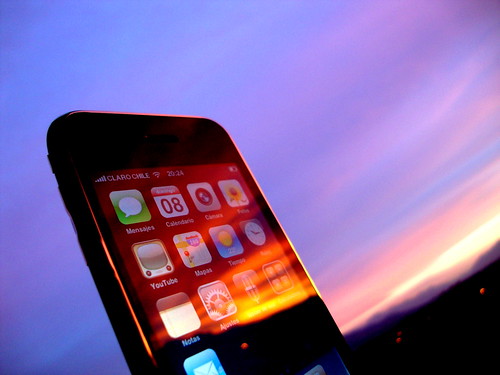One of the most universally dreaded errands throughout American history has been going to the bank. Synonymous with long lines, incompetent employees and bureaucratic nightmares, banking in person is rarely described as anything other than a necessary evil. Of course, face to face banking has become less frequent during the last decade, due to the rise of onlinebanking. The ability to pay bills, examine account balances and transfer funds with the click of a mouse has been nothing short of a godsend for most consumers. In fact, InternetFinancialNews.com stated in February 2009 that online banking has grown even more popular during the current recession, with “…28 percent of consumers saying they are using online banking more then they did a year ago” and another “…63 percent said managing all of their accounts online from one site would help them feel more in control of theirfinances.” However, even the relatively recent innovations of online banking are quickly being surpassed by the next big thing — mobile banking. While it’s barely been a decade since online banking gained mainstream appeal, it is now possible to do just about everything a bank website offers from a mobile phone. A group of friends searching for an ATM, for instance, need only useMasterCard’s ATM Hunter for the iPhone. Bank of America users can manage every facet of their accounts from their iPhone, Blackberry or Android. And of course, Mint offers an iPhone app for remotely tracking every bank, retirement and investment account you happen to have. But cool and exciting as these innovations are, they are actually just the beginning!
Below, we’ll comment on the future of mobile finance by profiling some of the most significant, new developments, some of which are already assisting consumers in all manner of remote transactions.
Mobile UPC Scanning

(Mu0x)
Perhaps the most intriguing development in mobile finance is how it extends far beyond simply bringing online banking to mobile phones. Indeed, the technology often extends beyond banking completely. One exciting example is mobile bar code scanning. While much remains to be done before mobile phones can scan and inventory bar codes as reliably as dedicated scanning equipment, early scanning programs already exist for the iPhone. One such program is RedLaser 2.0, which enables users to scan bar codes from a grocery store in real time. This has enabled consumers to comparison shop while standing in a store aisle by running scanned bar codes against a database of bar codes from competing stores and learning who has the cheapest price with moments.
Red Laser’s website postulates several other potential uses for mobile UPC scanning, including scanning a book for reviews while you’re in Borders and scanning movies to add them to your TiVo. Of course, not all merchants are as eager to embrace this technology as consumers are. In December 2008, ReadWriteWeb reported several instances of big-box retailers like Target requesting that customers stop scanning the bar codes in their stores, even going so far as to cite store policy. Fortunately, not all retailers are giving mobile UPC scanning the cold shoulder. Indeed, ReadWriteWeb declares that “…instant price match is retail’s future” and offers several ways for retailers to profitably engage users of such software, including offering “…easy-to-find bar codes on their promotional items with signage encouraging customers to compare the price instantly with other stores in the area” which would, in effect, “…make bar code scanning the new advertising circular.” One thing is for sure – it will be nothing short of exciting to witness the direction that mobile bar code scanning takes in years to come, especially with Venture Beat proclaiming in January 2010 that “…smartphones are one of the hottest growth sectors in our economy right now.”
iPhone-Based Credit Card Processing....

A popular misconception about iPhones is that they are merely “toys”. One of the most fascinating advances in mobile finance are iPhone-based credit card terminals. Gone are the days of small merchants and business owners having to buy expensive processing terminals before they can accept credit card payments. Tuaw.com profiles several iPhone-based credit card terminal apps that one can imagine being perfectly viable for just about any small shop owner to use — in fact, you don’t even need the shop. One of the featured apps (simply called Credit Card Terminal) is available for just $0.99 via the App Store and allows users to “…enter credit card information, complete transactions, and even view and refund past sales.” Another app called Billing: Credit Card Terminal retails for the higher price of $19.99 but includes the ability to record a customer’s signature as part of all transactions processed on your phone. International merchants aren’t left out in the cold, either. iSwipe Global supports over a dozen foreign currencies, as well as PayPal and CyberSwipe.
Admittedly, most major retailers wont be be jettisoning their swipe terminals for iPhone applications anytime soon. Still, the affordability and convenience they offer to smaller business owners is truly astounding. Even businesses that prefer standard credit terminals in their physical locations can benefit from the ability to close remote sales without being anywhere near a computer. And while some are skeptical (a commenter on Tuaw.com remarked “…illicit peddlers of goods just got a fantastic way to make cash free transactions”), it seems that the upside of this technology far outweighs the risks.
Extending Bank Accounts to the World’s Poor

Some analysts are also predicting that mobile banking will help extend banking services to the world’s poor. India’s Telegraph, for instance, reported in February 2010 that the “…State Bank of India will soon offer no-frills savings accounts on mobile phones” as part of a broader project to assist “…those who earn less than Rs 5,000 a month, own a mobile phone but do not have a bank account.” While this might appear to be a rather small slice of India’s population, the Telegraph estimates that “…at least 36 per cent of the Indian population falls in this category”, which includes such varied people as “…construction workers (often migrants), vegetable vendors, rickshaw pullers and railway porters.” India has ambitious plans for the program, which is designed to be as convenient and user-friendly as possible. Abhiskek Sinha, the CEO of Eko India Financial Services, told the Telegraph that all a customer of this program must do is “…go to his local grocery, or a mobile recharge agent or a chemist to get a zero balance account.” Following that, the user can “…deposit, withdraw, remit and check balances – all by just clicking a few buttons on the mobile phone.”
Together with the rise in international micro-lending to those in developing countries, wider use of mobile banking and finance software has the potential to make a difference in the lives of citizens of India and elsewhere. Anything mobile finance can do to spur greater participation in the banking systems of these countries has a tangible, immediate impact on those countries by increasing the funds available to local entrepreneurs and businesses.
The Future...
Despite whatever reluctance particular merchants and skeptics have, it is clear from observing these developments that mobile finance is here to stay. Indeed, it’s easy to imagine a time in the not-so-distant future when entrepreneurs can literally run every aspect of their business (from account management to credit card processing and more) from a standard smart phone. Initiatives similar to India’s hold the potential to get millions of the world’s poor involved in the mainstream financial system. More broadly, banks and investment houses may soon find themselves squeezed out of certain transactions entirely, as consumers gain the ability to handle more and more of their finances personally via automated mobile technology. All in all, it’s hard to envision any scenario where banking and finance wont change substantially in the next five to ten years as a result of mobile finance.
UPDATE: A special thanks to Budgets Are Sexy for including us in the 245th Carnival of Personal








0 comments:
Post a Comment
Note: Only a member of this blog may post a comment.